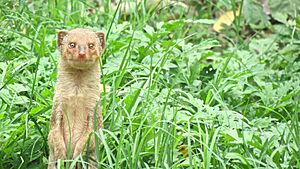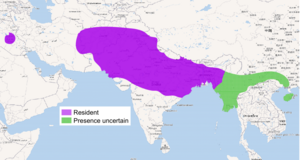Small Indian mongoose facts for kids
Quick facts for kids Small Indian mongoose |
|
|---|---|
 |
|
| Small Indian mongoose in Panna National Park | |
| Conservation status | |
| Scientific classification | |
| Genus: |
Urva
|
| Species: |
auropunctata
|
 |
|
| Native distribution of the small Indian mongoose in 2016 | |
| Synonyms | |
|
Mangusta auropunctata |
|
The small Indian mongoose (Urva auropunctata) is a type of mongoose. It naturally lives in countries like Iraq and northern India. However, people have also brought it to many islands in the Caribbean and Pacific oceans.
Contents
What is a Mongoose?
Mongooses are small, quick, furry animals. They are known for being very good at hunting. The small Indian mongoose is one of many different mongoose species.
About the Small Indian Mongoose
The small Indian mongoose has a thin body. Its head is long with a pointy nose. Its body and head together can be about 50 to 67 centimeters long. It has short ears and five toes on each foot with long claws. Male mongooses are usually bigger and have wider heads than females.
This mongoose is a bit smaller than the Indian grey mongoose. On islands where they have been introduced, these mongooses have grown larger. They also show more differences between males and females.
Where They Live
The small Indian mongoose is originally from a wide area. This includes Iraq, southeastern Iran, Afghanistan, Pakistan, India, Nepal, Bhutan, Bangladesh, and Myanmar. They can live in places as high as 2,100 meters (about 6,900 feet).
In Iraq, they live near rivers and in farm fields. In Pakistan, they can be found in hilly areas and national parks. In India, they live in forests and wildlife sanctuaries.
Mongoose on Islands
People have also brought the small Indian mongoose to many other places. These include some countries in Europe and islands in the Caribbean Sea, Indian Ocean, and Pacific Ocean. They were also brought to Okinawa in southern Japan.
Introduced to the Caribbean
In 1872, nine small Indian mongooses were brought to Jamaica from India. The idea was to help control black and brown rats on sugarcane farms. The mongooses quickly had babies and their numbers grew.
Sugarcane farms on islands like Hawaii and Fiji also had many rats. These rats caused a lot of damage to the crops. So, people tried to bring mongooses to other islands too.
However, bringing mongooses to these islands caused big problems for the native animals. For example, the number of native reptiles, like the green iguana, dropped a lot. Some lizards, like the ground lizard on St. Croix, even disappeared completely. Ground-nesting birds and small mammals were also likely harmed. Many native snakes on these islands were almost wiped out.
Introduced to Hawaii
Mongooses from Jamaica were sent to farms on other islands, including Hawaii. At first, people thought the mongooses were good at reducing rats and insects. But the mongooses also started eating native birds. These birds had never faced predators like mongooses before. Mongooses also raided the nests of green sea turtles, eating their eggs and baby turtles.
Introduced to Okinawa
The small Indian mongoose was brought to Okinawa Island in 1910. It was also brought to Amami Ōshima Island in 1979. The goal was to control a venomous snake called the Protobothrops flavoviridis and other animals seen as pests. But the mongoose itself became a pest.
Introduced to Dalmatian Islands
In 1910, the small Indian mongoose was brought to Mljet island in Croatia. This was done to control the horned viper, a venomous snake. The mongoose population grew and the number of vipers went down. But then, the mongooses started eating local birds and even farm chickens. They spread to other nearby islands like Korčula and Hvar. Even with rewards offered, it has been hard to control their numbers.
What They Eat
The small Indian mongoose eats many different things. In Pakistan, they mostly eat insects like dragonflies, grasshoppers, and ants. They also hunt small rodents like rats and shrews. Sometimes, they eat small amphibians, reptiles, and small birds. They can also eat seeds and fruits.
Health and Diseases
Small Indian mongooses can carry certain germs. For example, some on Okinawa Island had Leptospira and other bacteria. In Puerto Rico, the small Indian mongoose is a main animal that carries rabies. However, it is rare for rabies to spread from mongooses to humans.


